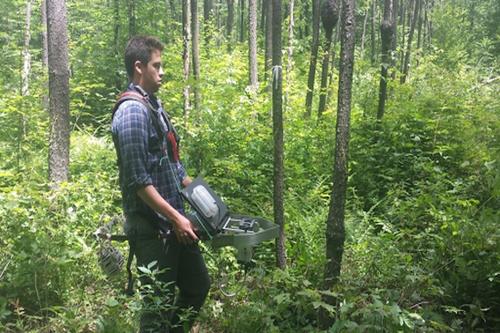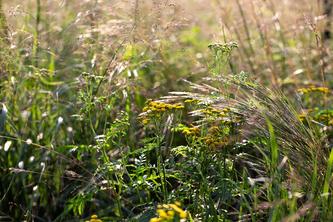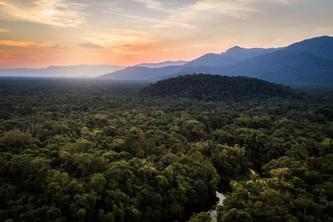Using lasers and a long-term experiment to investigate how deer change a forest canopy

MINNEAPOLIS/ST. PAUL (02/25/2022) — University of Minnesota researchers are using high-frequency lasers to learn more about how deer populations influence forest landscapes. From the far northern forests of Canada, through the temperate forests of the U.S. Midwest, to the tropical forests of Columbia, white-tailed deer are ever–present, overpopulated and can drastically change an ecosystem.
Research recently published in the Journal of Applied Ecology by Sam Reed, a PhD candidate in the Department of Forest Resources, and colleagues investigates how deer can change forest tree species and the resulting canopy.
The forest canopy is the uppermost layer of a forest, characterized by the crowns of the trees and including all of the plants and animals living in that layer.
Deer can change a forest by eating certain plant species and removing them from a landscape. After many years, a forest can be made up of plant species that deer do not like to eat and have left behind. These deer-induced species changes can then influence a forest canopy, as many trees have species-specific canopy architectures. Changes in the canopy have many implications for carbon sequestration, wildlife and understory communities.
"Deer choose to eat certain plants over others, and their preferences act as an invisible force that shapes the successional trajectories of forests. It’s amazing that something as simple as deer eating tiny tree seedlings can affect the way the forest looks and functions many decades later,” said Dr. Kathleen Knight, a research ecologist with the United States Forest Service.
The research team measured trees and their canopies in formerly clearcut sections of four 65-hectare deer enclosures that were in use from 1980 to 1990. Each enclosure was subdivided to maintain deer densities of 4, 8, 15, and 25 deer per square kilometer over 10 years.
Today, nearly 40 years after the enclosure experiment began, the trees in the canopy reflect the plant species that deer do or do not like to eat. These remnant trees allowed Reed and his colleagues to measure how deer densities can change a canopy with a portable canopy LiDAR (light detection and ranging) system, which uses high-frequency lasers to scan and quantify the arrangement of overhead leaves and branches.
“Up until very recently, we could not have done this study,” said Reed. “The portable canopy LiDAR system and other remote sensing technologies have opened up new possibilities in our understanding of deer and other disturbances.”
The researchers found:
- Deer can indirectly make canopies more open and widely spaced. High deer densities lead to stands dominated by black cherry, a tree that contains high levels of cyanide and is not edible by deer. These black cherry stands had low tree diversity and were very widely spaced, which was reflected in sparse canopies with many openings. In addition, canopies were taller and more horizontally complex with increased deer browsing.
- Deer can inadvertently change a forest’s biodiversity and canopy structure with enough time and browsing pressure. This under-considered ecological connection highlights the many ways that herbivores can change forests and the need to investigate their indirect effects on an ecosystem.
According to Reed, future research should consider using terrestrial LiDAR or other remote sensing techniques to investigate how other large herbivores can change forest canopy structure over long time spans.
“I think deer are an incredibly destructive force in eastern North America, and our results provide further credence to this,” he said. “These seemingly innocuous creatures have inadvertently changed entire forests and their canopies, which can then influence critical aspects of a forest, such as carbon sequestration and the prevalence of wildlife habitat.”
Other members of the research team include Alejandro Royo, Alexander Fotis, Kathleen Knight, and Charles Flower of the USDA Forest Service; and Peter Curtis of Ohio State University. Funders of this research include the U.S. Forest Service Northern Research Station and the Ohio State University Undergraduate Research Office.
-30-
About the College of Food, Agricultural and Natural Resource Sciences
The University of Minnesota’s College of Food, Agricultural and Natural Resource Sciences (CFANS) strives to inspire minds, nourish people, and sustainably enhance the natural environment. CFANS has a legacy of innovation, bringing discoveries to life through science and educating the next generation of leaders. Every day, students, faculty, and researchers use science to address the grand challenges of the world today and the future. CFANS offers an unparalleled expanse of experiential learning opportunities for students and the community, with 12 academic departments, 10 research and outreach centers across the state, the Minnesota Landscape Arboretum, the Bell Museum of Natural History, and dozens of interdisciplinary centers.
- Categories:
- Agriculture and Environment
- Animals





